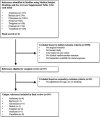Environmental Metals and Cardiovascular Disease in Adults: A Systematic Review Beyond Lead and Cadmium
- PMID: 27783356
- PMCID: PMC5801549
- DOI: 10.1007/s40572-016-0117-9
Environmental Metals and Cardiovascular Disease in Adults: A Systematic Review Beyond Lead and Cadmium
Abstract
Published systematic reviews concluded that there is moderate to strong evidence to infer a potential role of lead and cadmium, widespread environmental metals, as cardiovascular risk factors. For other non-essential metals, the evidence has not been appraised systematically. Our objective was to systematically review epidemiologic studies on the association between cardiovascular disease in adults and the environmental metals antimony, barium, chromium, nickel, tungsten, uranium, and vanadium. We identified a total of 4 articles on antimony, 1 on barium, 5 on chromium, 1 on nickel, 4 on tungsten, 1 on uranium, and 0 on vanadium. We concluded that the current evidence is not sufficient to inform on the cardiovascular role of these metals because of the small number of studies. Few experimental studies have also evaluated the role of these metals in cardiovascular outcomes. Additional epidemiologic and experimental studies, including prospective cohort studies, are needed to understand the role of metals, including exposure to metal mixtures, in cardiovascular disease development.
Keywords: Atherosclerosis; Cardiovascular; Epidemiologic studies; Metals; Systematic review.
Conflict of interest statement
Anne E. Nigra, Adrian Ruiz-Hernandez, Josep Redon, Ana Navas-Acien, and Maria Tellez-Plaza declare that they have no conflict of interest.
Figures


References
-
- Messner B, Bernhard D. Cadmium and cardiovascular diseases: cell biology, pathophysiology, and epidemiological relevance. Biometals. 2010;23:811–22. - PubMed
-
- Lamas GA, Goertz C, Boineau R, Mark DB, Rozema T, Nahin RL, et al. Effect of disodium EDTA chelation regimen on cardiovascular events in patients with previous myocardial infarction: the TACT randomized trial. JAMA. 2013;309:1241–50. This large, randomized, placebo-controlled trial found that edetate disodium chelation therapy significantly reduced cardiac events in stable post-myocardial infarction (MI) patients. - PMC - PubMed
Publication types
MeSH terms
Substances
Grants and funding
LinkOut - more resources
Full Text Sources
Other Literature Sources

